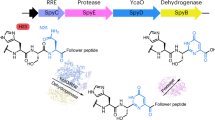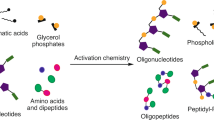Abstract
SINCE it gives rise to 5′phospho oritidine which is rapidly transformed into pyrimidine nucleotides1, orotic acid is useful in the investigation of nucleic acid biosynthesis. It seems to accumulate temporarily in plants before it is utilized as a precursor of the nucleotides2.
Similar content being viewed by others
Article PDF
References
Lieberman, I., Kornberg, A., and Simms, E. S., J. Amer. Chem. Soc., 76, 2844 (1954).
Buchowicz, J., and Reifer, I., Acta Biochim. Polon., 9, 63 (1962).
Joussaume, M., and Bourdu, R., Physiol. Vég., 2, 329 (1964).
Karasek, M., and Schramm, G., Biochem. Biophys. Res. Commun., 9, 63 (1962).
Kirk, J. T. O., Biochem. Biophys. Res. Commun., 14, 393 (1964).
Semal, J., Spencer, D., Kim, Y. T., and Wildman, S. G., Biochim. Biophys. Acta, 91, 205 (1964).
Brachet, J., and Goffeau, A., C.R. Acad. Sci., Paris, 259, 2899 (1964).
Author information
Authors and Affiliations
Rights and permissions
About this article
Cite this article
JOUSSAUME, M., BOURDU, R. Conversion of Carbon-14-labelled Orotic Acid into Pyrimidine Nucleotides by Chloroplasts. Nature 210, 1363–1364 (1966). https://doi.org/10.1038/2101363a0
Published:
Issue date:
DOI: https://doi.org/10.1038/2101363a0
This article is cited by
-
Glutamine synthetase in the chloroplasts of Vicia faba
Planta (1973)
-
RNA-synthesis inAcetabularia
Protoplasma (1967)



